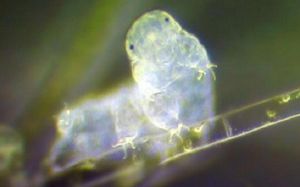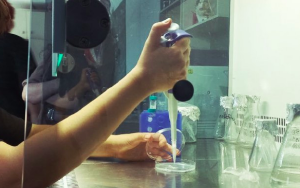Tardigrades are microscopic animals (500 µm on average) popularly known as water bears and truly remarkable for their high resistance to extreme environments such as freezing, boiling water, starvation for decades... these are conditions where other life forms would not resist.
This is made possible by their ability to shut down their organs when environmental conditions are not suitable (an ametabolic state called anhydrobiosis) and come back to life when optimal conditions are restored.
One of the reasons these organisms are so resilient is because of a protein that only they produce. These abundant heat-soluble cytoplasmic proteins (CAHS) cause the inside of the cells to turn into a gel, which prevents the cell from collapsing.
They live in humid areas, and can easily be found in mosses where they feed on plant cells or small invertebrates.
In the laboratory, we could take care of some of them. First we disolve the initial sample which had a huge amount of tardigrades and as food they had algae. Then some of them were "sacrifice" as a contaminated sample so we could observe them through the microscope.
At the begining they where looking full of food but after a month in this contaminated*(you don't say contaminated, it's just a sample) sample we found most of the tardigrades went to sleep mode probably due to lack of food.
Alessandro's input:
We got clean tardigrade cultures of Hypsibius exemplaris and the algae on which they feed, Chloloroccum sp.
Each week we removed some water from the tardigrade flask, and add some water from the Chlorococcum flask. This way we feed them. The number of tardigrades in the culture increased significantly.
Chlorococcum was cultivated by refilling the missing water with spring water with 0,01% of plagron algal fertilizer.
Then you can say which impression did you have while looking at it and learning about them
Webgraphy_
Montejo, E. (2022, 22 septiembre). Científicos revelan el secreto que hace inmortal a los tardígrados. National Geographic En Español. https://www.ngenespanol.com/animales/descubren-por-que-los-tardigrados-son-practicamente-indestructibles-y-sobreviven-a-condiciones-extremas/



